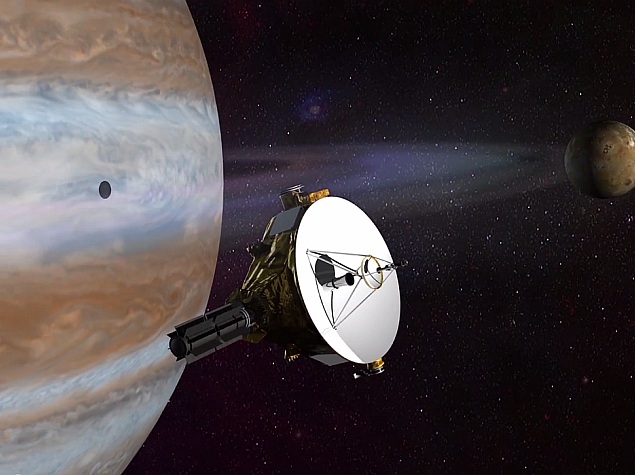- Home
- Science
- Science News
- Nasa's New Horizons Probe Begins Six Month Approach to Pluto
Nasa's New Horizons Probe Begins Six-Month Approach to Pluto

US space agency Nasa said its New Horizons spacecraft Thursday officially began its six-month approach to Pluto, with the first close-up flyby scheduled for July 14.
After a voyage of nine years covering 4.8 billion kilometres (3 billion miles), the piano-sized probe awoke from its final hibernation period in early December for the encounter, and Thursday, several science instruments on board, including a space-dust detector, were activated, Xinhua reported.
"We've completed the longest journey any craft has flown from Earth to reach its primary target, and we are ready to begin exploring!" Alan Stern, New Horizons' principal investigator from Southwest Research Institute, said in a statement.
According to the space agency, the photo shoot of the Pluto system using the probe's Long-Range Reconnaissance Imager will begin January 25.
The pictures will not only help mission scientists understand the dynamics of Pluto's moons, but also play a critical role in navigating the probe as it covers the remaining 220 million kilometres (135 million miles) to the dwarf planet, N said.
"We need to refine our knowledge of where Pluto will be when New Horizons flies past it," said Mark Holdridge, the New Horizons' encounter mission manager from Johns Hopkins University.
(Also See: Nasa's Curiosity Rover Set to Drill Into Crystal-Rich Rock on Mars)
"The flyby timing also has to be exact, because the computer commands that will orient the spacecraft and point the science instruments are based on precisely knowing the time we pass Pluto which these images will help us determine."
The probe's instruments will also measure the high-energy particles streaming from the sun and dust-particle concentrations in the inner reaches of the Kuiper Belt, the unexplored outer region of the solar system that includes Pluto and potentially thousands of similar icy, rocky small planets.
Pluto's closest approach is scheduled for July 14, when New Horizons will pass within 10,000km (6,200 miles) of the dwarf planet's surface, travelling at a speed of 43,000km (27,000 miles) per hour.
The probe will then head farther into the Kuiper Belt to examine one or two of the ancient, icy small worlds in that vast region, which is at least 1.6 billion kilometres (one billion miles) beyond Pluto.
For the latest tech news and reviews, follow Gadgets 360 on X, Facebook, WhatsApp, Threads and Google News. For the latest videos on gadgets and tech, subscribe to our YouTube channel. If you want to know everything about top influencers, follow our in-house Who'sThat360 on Instagram and YouTube.
Related Stories
- Samsung Galaxy Unpacked 2025
- ChatGPT
- Redmi Note 14 Pro+
- iPhone 16
- Apple Vision Pro
- Oneplus 12
- OnePlus Nord CE 3 Lite 5G
- iPhone 13
- Xiaomi 14 Pro
- Oppo Find N3
- Tecno Spark Go (2023)
- Realme V30
- Best Phones Under 25000
- Samsung Galaxy S24 Series
- Cryptocurrency
- iQoo 12
- Samsung Galaxy S24 Ultra
- Giottus
- Samsung Galaxy Z Flip 5
- Apple 'Scary Fast'
- Housefull 5
- GoPro Hero 12 Black Review
- Invincible Season 2
- JioGlass
- HD Ready TV
- Laptop Under 50000
- Smartwatch Under 10000
- Latest Mobile Phones
- Compare Phones
- Moto G15 Power
- Moto G15
- Realme 14x 5G
- Poco M7 Pro 5G
- Poco C75 5G
- Vivo Y300 (China)
- HMD Arc
- Lava Blaze Duo 5G
- Asus Zenbook S 14
- MacBook Pro 16-inch (M4 Max, 2024)
- Honor Pad V9
- Tecno Megapad 11
- Redmi Watch 5
- Huawei Watch Ultimate Design
- Sony 65 Inches Ultra HD (4K) LED Smart TV (KD-65X74L)
- TCL 55 Inches Ultra HD (4K) LED Smart TV (55C61B)
- Sony PlayStation 5 Pro
- Sony PlayStation 5 Slim Digital Edition
- Blue Star 1.5 Ton 3 Star Inverter Split AC (IC318DNUHC)
- Blue Star 1.5 Ton 3 Star Inverter Split AC (IA318VKU)

















